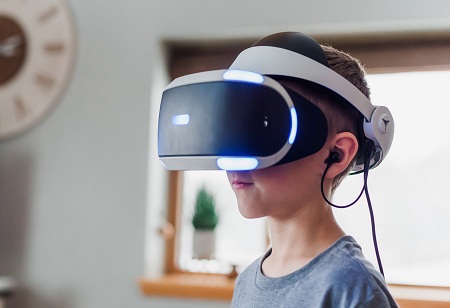
Virtual Reality (VR) is nowadays being utilized to generate virtual simulations of manufacturing scenarios in which engineers can research, experiment and optimize their designs. It assists in the guidance of employees to become more familiar with the manufacturing process. VR contributes to cost reduction improved efficiency and increase in safety in the manufacturing process. VR can be used to offer customers a pragmatic view of a product or service prior to the purchase of it. This facilitates companies to amplify the sales and lead to customer satisfaction. To add to that, VR allows for remote collaboration between multiple teams, allowing for quicker problem solving and better communication. VR also allocates for the simulation of dangerous situations, helping to reduce the risk of injury or accidents in the workplace. The outcome of this is cost savings for companies as well as improved security for employees. VR can also be utilized to create immersive experiences that can help to increase brand awareness and customer loyalty. It is being employed to create virtual simulations and training programs that can help to improve employee performance. The virtual simulated environments created by VR can assist employees to comprehend and practice safety protocols in a risk-free environment, allowing them to be better equipped for real-world scenarios. Moreover, immersive experiences can cater to a more engaging relationship with clientele, which can improve customer loyalty and increase brand awareness. Lastly virtual simulations and training programs is being used nowadays to help employees learn and practice new skills, leading to enhanced performance and cost savings for companies.
Virtual Prototypes
Virtual Reality provides the space for manufacturers to design virtual prototypes, to experiment with ideas and to enhance competence. It optimizes the time and resources required to create physical prototypes. VR can be utilized to instruct employees in a secure, realistic environment. It provides remote assistance to technicians in the respective fields. VR is being employed to boost collaboration among teams and locations, allowing them to experience, interact and cooperate within the same environment. VR enables companies to create immersive experience for the clientele, allowing them to virtually explore the comprehensive range of products and services. This is unique and promising for companies providing their customers a more comprehensive understanding of their products or services, which can lead to elevated customer satisfaction and more effective training. To add to that, VR authorizes companies to create interactive simulations that can aid employees to practice and pertain their skills in a realistic environment, thus improving their efficiency. Leveraging VR to create an immersive and engaging learning experience, many companies in the manufacturing industry can assist employees and customers alike to get the most out of their products or services, ultimately leading to better performance and satisfaction.
Virtual simulations of Equipment
Through VR, companies can create virtual simulations of equipment and processes that employees can interact with and learn from. This not only saves time and money, but it also allows employees to gain valuable skills and experience in a safe and controlled environment. This is particularly beneficial for employees who are unfamiliar with certain types of equipment or processes, as it eliminates the need for costly and time-consuming on-site training., the virtual simulations can be modified or updated quickly and easily to reflect changes in equipment or processes. This ensures employees stay up to date with the latest processes and techniques, reducing frustration and improving productivity. Additionally, the simulations enable employees to practice without the risk of damaging expensive equipment or endangering themselves and others. For example, a virtual simulation for a manufacturing line can be used to instruct new employees on the correct use of the machinery without having to worry about safety risks or the cost of replacing faulty machinery.
Immersive, interactive training programs
VR can be used to create immersive, interactive training programs that can be more efficient in comparison to traditional methods. It can be used to produce virtual prototypes that can be tested and refined before being implemented in production. This type of technology allows for an environment that is both realistic and engaging, allowing learners to fully understand the concepts being taught. In addition, virtual prototypes can be tested and examined in an extensive manner, allowing for a more thorough evaluation before the product is released. This process ensures that products are of the highest quality and meets the customer's needs. It reduces the time and cost of development, resulting in a better product and more satisfied customers. For example, virtual prototypes can be tested in extreme conditions such as heat, cold, and vibration, far beyond the capabilities of physical prototypes.
In a nutshell, virtual reality is being employed in manufacturing sectors by manufacturers to promptly create virtual prototypes and assess them for quality and functionality. This leads to premium quality products in a shorter amount of time, ultimately leading to more contented customers and increased profits. VR helps manufacturers to reduce costs, as it eliminates the need for physical prototypes and allows them to promptly make changes in the virtual environment. In an exclusive interview with Mr. Aditya Chikodi – GM & Head, Innovation Design & Visualization practice at Tata Elxsi published in CXOToday it mentions that - Over the next five years, the demand for AR/VR technologies is set to skyrocket. According to a report by Markets and Markets, the global AR and VR market is projected to grow at a Compound Annual Growth Rate (CAGR) of 46.6%, from $6.1 billion in 2020 to $40.4 billion by 2025. Virtual Reality (VR) and Augmented Reality (AR) are poised to revolutionize the way consumers interact with the world around them. These two technologies will redefine the future of consumer experiences and interactions, transforming the way we learn, work, and play.

